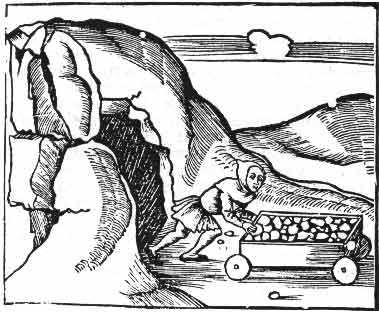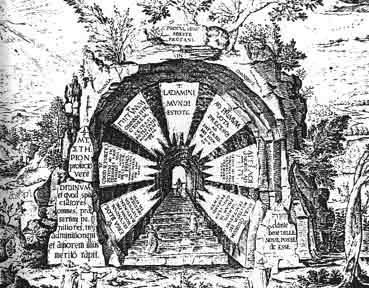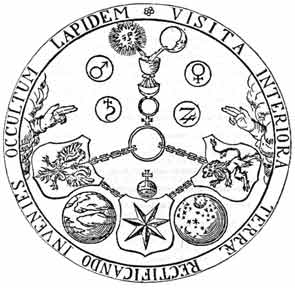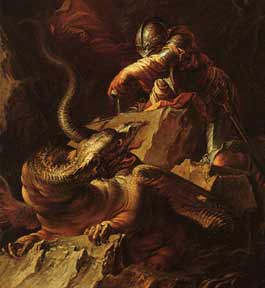1.The Great Work
Jesus said: "Let him who seeks
continue
seeking until he finds.
When he finds,
he will become troubled.
When he becomes troubled,
he will be astonished,
and he will rule
over the All."
The Gospel of Thomas, verse 2
1.1 Vitriolum
…and as long as you do not have the wisdom,
die to become,
you will only be a sad guest on this dark earth.
Goethe
He who wants to enter the divine realm,
first must enter
his mother’s body,
and die herein.
Paracelsus
Carl Gustav Jung
said: " He who looks in the mirror of the water, first sees his own
image. He who looks at himself, risks to meet himself. The mirror does
not flatter, it shows accurately what is reflected in it, namely that
face that we never show the world because we hide it by the persona, the
mask of the actor. This is the first test of courage on the inner path,
a test, which is enough to frighten most people, because the encounter
with oneself belongs to those unpleasant things, one avoids as long as
one can project the negative onto the environment."
The acronym
V.I.T.R.I.O.L.U.M., used in alchemical literature, is formed by the
Latin expression "Visita Interiora Terrae Rectificando Invenies Occultum
Lapidem Veram Medicinam", what means "Visit the interior of the earth,
and by rectifying you will find the hidden stone which is the true
medicine".

The alchemist mining the earth. Mining or going inside the earth is the first step in the alchemical process. The earth is the body or oneself. Going inside the earth is equal to going into your inner self.
Thus we are invited to descend into the earth, into the
underworld, or the unconscious. The earth is the symbol of physical man.
Man needs to become conscious of his inner world, who he is, what he is
doing, what his motives are, and so on. Once attention is directed
inwards, a whole new world opens: the underworld of Hades, the dark
realm of shadows and monsters.
This descent is also called ‘regressus
ad uterum’, ‘the return into the uterus’, a term often used in
initiation rites. It is a symbolic return to a particular primal state
of being that every man is carrying in his collective unconscious. Deep
inside man, in the darkness of his psyche, are the causes or origins of
man’s actions. Therefore the ‘regressus ad uterum’ is a necessary
condition to enter the moonlit area of death, and subsequently
experience rebirth. Terra Mater, Mother Earth, has always been connected
with birth, with the connection between man and woman (=the conscious
and the unconscious), from which new life springs up after death.
Primitive people performed their initiations in darkness or under the
ground, like in caves. In Egypt initiations were performed in the
pyramids or in underground crypts of the temples. In Persia it was
mostly in caves, with native Indians is special huts. The Mythras
mysteries were conducted in temples built underground. The initiation
itself was symbolized by the penetration of the belly of the Great
Mother, or of the body of a sea monster or wild animal.
In Greek
mythology Orpheus descended into the Hades to look for Eurydice (=symbol
of his lost soul). The Indian god Krishna descended into the hells to
look for his six brothers (=the six chakras, Krishna being the crown
chakra). There is a legend that after his death Jesus descended into the
realm of Satan to save the soul of Adam (=the pure man).

The Gate to Eternal Wisdom (Heinrich Khunrath, Amphiteatrum Sapientiae, Hanau, 1604).
In alchemy, the entrance into the unconscious is
represented by the entrance into caves, by reports of travels to the
underworld or strange parts of the world. Another important
representation is the king who is taking a bath. The conscious is the
king, and the bath or bath water is the unconscious. By bathing he
enters into the unconscious. In alchemical terms he is being permeated
by the water (aqua permanens) or quicksilver.
Another symbol is the
‘coniunctio’ (conjunction) or ‘conceptio’ (conception) that primarily
takes place in water, in a spring or a fountain. The queen then
represents the feminine, water, the unconscious.
The descent into the
unconscious is not without dangers. In the psychological sense it can
result, for example, in schizophrenia. In mythology the hero penetrates
the underworld to fight monsters and demons. The Great Mother appears to
him in the image of a terrible being, often as the Ruler of Death. For
his courage and bravery, the Great Mother, as goddess of fertility,
offers him great knowledge and wisdom.
In alchemy, when working with
(symbolic) metals, lead is used as initial material. The alchemists say
that in lead there is a demon that can cause insanity. Lead as a metal
is under the rulership of Saturn, the god of melancholy, who causes
ailments and devilish visions.
Lead, the most impure metal, needs to
be transformed into the pure metal, gold. In general, lead means
impurity, the impure body, or impure man.
After the alchemist has
entered the earth, he must rectify (rectificando). What does this mean?
A text from the modern syncretistic Taoism: "That is why Buddha Jou-lai
(Tathagata), in his great mercy, has revealed the method, the alchemical
work of Fire, and taught people to rectify their true nature and
fullness."

(Solomon Trismosinus, Aurum vellus, Hambutg, 1708)
In
the outer circle is the Latin sentence of vitriolum.
The sun and the moon are the opposites in man that have to be united. The chalice is the alchemical 'vas' or vat, symbol for the body. The planetary signs represent different stages of the alchemical process. The double eagle is Mercury, the lion is Sulfur and the star is Salt, the three ingredients of the process. The left globe with clouds is the microcosmos; the right globe with the stars is the macrocosmos.
‘Rectificando’ in the middle of the acronym VITRIOLUM means ‘to put
right’ in the moral sense, to reinstate the true nature, the
purification of negative emotions and so on. It is to straighten that
what has grown crooked during our lives. The alchemist must purify
himself of all ‘dirt’, of all his ‘dross’. He has to wash ‘the body’ to
ameliorate and improve it. The metals have to be purified from the
‘external, impure and destructive elements’. The metals here can be seen
as the emotions.
Taoism stresses the importance of purifying the
egotistic tendencies which distance man from his eternal nature. A man
who strives for the Tao must give up all lusts and desires, and become a
child joining the Tao. By this purification rebirth happens. Therefore
an alchemist has to shy away from the masses, and start the process of
‘meditatio’, self-reflection, in silence.
Buddhism also teaches
purification. Man can reach salvation by disconnecting himself from the
temporal things that make him stray off the true path. He sees that life
is temporal and is by itself not satisfying. Man is unsatisfied because
his desires are limitless. He has to unchain himself from his desires.
Going into the unconscious also means to go into the collective
unconscious we all share. In Greek mythology there was Tartaros, a name
originally used for the entire underworld. Tartaros is the psychic world
deep in man where all those nasty emotions reside, like the lust for
murder and destruction, thirst for blood, fear, hate, revenge, the lust
for power, melancholy and so on. It is not easy to admit to oneself, but
they all reside in ourselves. Because we don’t like it, we have cut
ourselves off from being aware of this dark realm. We have repressed all
our dark emotions into this deep realm of Tartaros. This is the heritage
of man, dating from ancient times.
The task of man is to feel and be
responsible for all his emotions, not to repress them, but to change and
transmute them into higher feelings. Repression chains man to the very
objects of repression, but purification will transmute them positive
elements bringing him closer to his true essence. As long as we do not
take up the Great Work, pain and misery will disturb our lives. We have
to face the mythical monsters in the depths of our unconscious and shed
light on them. As they are part of being human, we cannot discard them,
but we can control them, master them, learn from them, and transform
them into servants of the Divine. The monsters are not monsters by
themselves. They are just characteristics of human nature that have
become distorted. We can rectify them and make them shine in their
original beauty.
This task is not for the would-be initiate. It is
only for the brave who dare to face the darkness of the soul. Many will
fail in their courage and return home. Thus the pilgrim is not going on
an easy path, as the world of pleasure is not his anymore. He has chosen
the path of Arete (=goddess of Virtue), leading him to many dangers and
difficult paths, in solitude and starvation, but eventually he will
become immortal. He who will lose life, will gain it.
If you are
really determined
to find Tao,
you can do that even when you are
in a city
and have a high position in worldly affairs.
That is not
contradictory.
The work is easy and close by,
the secret is so
simple,
that, if it were disclosed,
laughter would be all around.
1.2 The Dragon
The stilling of the heart
is the true
alchemy
which turns mercury into silver.
Inayat Khan
While
common man
looks to blame other people
and blame fate,
noble
man
looks for the fault
within himself.
I Ching
In alchemy
the dragon corresponds closely with what Carl Gustav Jung called the
Shadow. The Shadow is the name for a collection of characteristics and
impulses which could be conscious, but which are denied. At the same
time we recognize and see them in other people. Some examples of the
Shadow are: egotism, laziness, intrigues, unreal fantasies,
indifference, or being obsessed by money and possessions. The Shadow is
the inferior being in us that desires what we do not allow ourselves
because it is uncivilized, because it is incompatible with society’s
rules and with the image of our ideal personality. It is all that what
we are ashamed of.

(Johann Daniel Mylius, Philosophia reformata,
Frankfurt, 1622)
To the right we have the alchemist with a dark face
what relates to the first phase of Nigredo during which the dragon is
killed, that is transformed by the penetration of the secret fire (the
arrow) of the archer. The drawing is based on the myth of Apollo who
killed the python of Delphi. The lion is the image of the animal
passions.
The dragon always resides in caves, and thus in the earth,
the underworld, and the unconscious. When the dragon leaves his cave he
devours virgins. It is our inner emotional dragon that destroys our
virgin consciousness, as when he appears in the conscious, expressing
negativity, like envy, jealousy, hate and so on.
The dragon is never
satisfied. He ever wants more treasures, more virgins. Is this not a
true image of common man? Consciousness and alertness are enchanted by
the dragon. The mythological dragon has the power to enchant, to
hypnotize with his voice the brave knight who dared to challenge him.
The dragon can also impose riddles in which the knight gets lost.
If
we want to save the pureness of consciousness (=the virgin), then the
dragon has to be killed. Actually this expression is not quite right. In
a few tales where the dragon is conquered and made tame, he is
penetrated by a lance with an iron point. Iron was always regarded a
special metal, as it was found in meteorites. As the metal associated
with Mars, iron has an active, destructive force. The lance, as a
phallic symbol, is the alchemical ‘secret fire’. The penetration of ‘the
body’ (here the dragon) with a lance is the penetration of physical
matter with the alchemical fire. In the same manner the Greek god of the
sun, Apollo, penetrated the Python of Delphi, with arrows, and let the
Python rot away next to the temple. Since then this place is called
Pytho (=putrefaction). Putrefaction is the first phase of the great
Work.
The dead dragon undergoes a transmutation. The dead dragon is
not an end, but the beginning of the Great Work. From the dead dragon,
vapors and volatile substances arise, often seen in alchemical images.
In other terms, the earth is partly being transformed into water, it
ascends as vapor.
Some sources say that in the head of the dragon is
a stone, a clear reference to the rough stone, or ‘prima materia’
(=first matter).
Killing the dragon also refers to a cosmic
happening. It is the penetration of the ‘prima materia’ as primal ocean,
or primal chaos by the secret fire or the divine spirit. The fiery
serpent emanated fire and light into the primal waters. When the dragon
(or serpent, as the cat of Ra the sun god cut off the head of the
serpent Apophis), is killed, the original chaos ceased and the process
of cosmic evolution started.
In Greek mythology the hydra of Lerna
was also a kind of dragon with similar symbolism. Hercules killed the
hydra in the second of his twelve works. The hydra of Lerna lived in a
swamp, the residence of primal instincts, passions, lusts, desires.
Anyone who gets involved with these emotions gets into a swamp in which
he drowns. Therefore Hercules shot fiery arrows (the alchemical fire) to
get her out of her hiding place. First he cut off the hydra’s heads, but
they grew back. A energetic approach is not the right way. Then his
nephew Joales comes to rescue. He starts to singe the cuts with flaming
tree trunks, so new heads cannot be formed. It is a systematically,
patient, reflective and profound attitude that is required.
When the
alchemists talk about the Green Dragon then they are talking about the
universal spirit that is present in everything, it is not the same as
the dragon of the underworld.